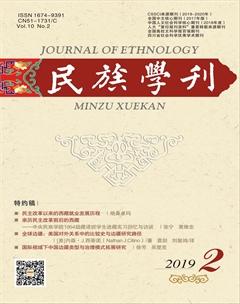The Evolution of the elief in the Wood God andthe Images of Trees Found on the 獼iama of the Dali ai People
Li Xiaojue
Astract:Jiama are images of gods printed on paper from woodlocks. They are mainly used in sacrificial activities, and closely reflect folk eliefs and folk life. The main suject matter to which Jiama refers is a series of gods and spirits/ghosts which exist within the spatial oundaries of peoples eliefs. So, the process of creating Jiama is not a simple description of specific ojects, ut a description and expression of concepts in peoples elief systems. Folk eliefs are the spiritual asis for the existence of Jiama. They are also the source of the symolic meaning of Jiama images, and they govern the process of making and using them . The deep symolic meaning emedded in the Jiama images originates from the knowledge systems related to folk eliefs. The more the kinds of gods are active in the folk elief systems, the more aundant the suject types of Jiama. This is the fundamental driving force of the Jiamas continuous innovation and evolution. At the same time, the degree of peoples knowledge aout and understanding of Jiama is related to their familiarity with folk eliefs. Therefore, it is helpful to study ojectively the present situation of folk eliefs y studying the system of the deities on the Jiama.
From the perspective of folk sacrificial rites, those rites prevalent in the village life of the Daliai people are the primary way to use Jiama, and these rites themselves ecome the most direct reason for the existence of Jiama. The linguistic environment must also e studied when analyzing the connotation of Jiama images. The producers of Jiama consolidated the symolic meaning in Jiama in the form of symols, and the users of Jiama used these ideographic symols to interpret the symolic meaning of Jiama within the context of the rituals. Every time a Jiama is used, it is accompanied y the recurrence and intensification of folk eliefs. A study of the deities and various religious factors which had a profound influence on Dali area throughout history , and which provide a layer y layer analysis and description of them helps to sort out the religious culture of the Dali ai and presents clearly the cultural forms emodied within the Jiama.
The themes of the Jiama are related to the folk elief systems of a specific ethnic group in a specific area, and their usage is inevitaly related to sacrificial rites. Therefore, when analyzing the Jiama images, it must e from the perspective of culture and folklore. During the past ten years, scholars have conducted numerous indepth discussions and studies on Jiama from the perspective of folk customs, which involved the systems of the gods, cultural values, social functions, characteristic ways of thinking, sacrificial rituals and folk oral literature of Jiama. However, due to the extremely rich categories of Jiama images and the inconsistency of the images when they spread to different regions, current scholarly research on the cultural interpretation of specific Jiama images is still weak. Therefore, under a specific cultural ackground, it is only feasile to carry out a detailed image analysis of a specific type of Jiama, explain the cultural connotations of a specific image y comining the folk eliefs of specific users, and separate out the evolutionary process of a specific elief.
The complex structure of the folk eliefs of the Dali ai people was formed y the accumulation and fusion of eliefs from different sources throughout a longterm historical process. The preference for the ancient versions of the Jiama in ai villages lends the Jiama images a historical continuity, illustrating the specific forms of various gods that are or were active in their elief systems over a long period of time. The particularity of the Jiama is that they can display diachronic cultural information within images that exist synchronically. This provides a asis for us to analyze the development trajectory of folk eliefs. Trees and wood are very common in the daily life of the Dali ai people. In most of the ai villages, there are several ancient trees, and these ancient trees often constitute one of the core areas of oth day to day life and religious activities of the villagers. In addition, a large amount of wood is used in the traditional residences of the ai. Thus, in the process of uilding a house, and until its completion, people are in contact with wood and the carpenter. Therefore, intensive sacrificial ceremonies and rituals are neededones in which the Wood God participates. However, in these ritual activities, the peoples elief in Wood God is varied. People distinguish etween different kinds of Wood Gods, and, as such, they will choose different types of Jiama paper images. They will do this even though they cannot explain the differences and connections etween them; nor do they pay much attention to the cultural remnants associated with aspects of primitive religions which appear in the Jiama picture.
As for the Wood God in depicted in the Jiama which are now popular among the Dali folk, the use of trees and graphic elements related to trees are a it complex and diverse. There are images of processed timer, twisted ranches and large trees with complete ranches and leaves, as well as personalized images of the Wood Gods, Carpenter Gods, etc. Actually, all these images and symols contain aundant cultural information elonging to different periods of development of Wood God eliefs.
First of all, in the elief system of primitive nature worship, large trees are the medium of communication in the sacrificial rituals, and as such are a natural force that can influence natural disasters or human reproduction. They are worthy, sacred and inviolale. Large, ancient trees are depicted as Wood Gods directly in such Jiama paper images.

